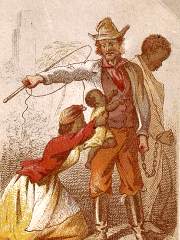

Given that my mother was born in West Virginia, I have suspected for a long time that many of my ancestors were slave owners.
Some of their slaves were freed upon the death of their owners.
Judy Rosenthal, Associate Professor of Anthropolgy, University of Virginia wrote:
This Web page is an acknowledgement of my "indebtedness to slaves, of overdue recognition of beholdenness."
Major James McKinney was the 2x great-grandchild of Abraham Soblet and Susanne Briant and he was my hird cousin, 6x removed.
"James McKinney is listed on the LVA 1812 muster rolls as James McKinny- Muster Rolls, p.705 -Part of index to: Pay Rolls of Militia Entitled to Land Bounty Under the Act of Congress of Sept. 28, 1850 (Richmond, 1851) and: Muster Rolls of the Virginia Militia in the War of 1812 (Richmond, 1852) which supplements Pay Rolls. This collection is also available on microfilm."
Major McKinney became the owner of 6 slaves 16-45 and 2 slaves 10-16.
In his father's will, he was bequested:
The following slaves are know to have been slaves of his father: Bett; Vis Sall and Rachel; Vizt Amy and Will; Jenny and Mary; Moll and Hannah; Isaac and Nan; Micajah Luck and Beck; Vizt Polk and Franky, and Peter.
We know the names of at least three of his slaves that he freed, Molly, Seally, and Sampson, from his will:
"SAMUEL FERGUSON’s interesting Will gave his home farm (that is, after his wife’s death) to his son Sam, Jr. He made provision, also after the death of his wife, to liberate and free an elderly black slave named Molly. He further provided for molly a bed and its furnishings, and a cow. He also liberated from slavery a girl known as Seally and willed to her a bed and its furnishings, plus a title wheel to use for spinning. SAMUEL continued with thoughtfulness for his slaves and set free (at the end of thirteen years from the date of his Will) a young boy named Sampson. He was to be given "…a good ax at the time of his freedom so he might be able to get his living by honesty and industry."
We know the names of the following slaves from his will: Sally, Nancy, Livey, Nancy, Tom, Abram Jr., Shed, Polly and Jennit, Clara, Amey, Jimey, Henry, Haris, and Hampton.
We also know the name of a slave that was to be returned to him:
We know the names of the following slaves from his will: Charles, Indian, Ceasar, Sam, Paul, Chester, Bob, Fanny, Hanover, Bob, Ben, Sue, Frank, Annaca, Little India, Daniel and Arthur, James, Little Sam, Dick and Harry.
We know the names of the following slaves from his will: Dufney, Prudence, Rachel, Randol, Gundy, Bob, and Ben.
We know the names of the following slaves from his will: Harry
We know the names of the following slaves from his will: Rawley, Mahaly, Jordan, Young Ransom, America, Daniel, Dilcy, Israel, Eliza, Rachel, Anthony, Mason, and Joe.
We know the names of the following slaves from his will: Mengo, Ned, Moll, and Morea.


At right, an African American family is separated by the slave trade. Picture is courtesy of Download-Free-Pictures.com.
If you have either black slaves or black slave owners in your family tree, I highly recommend that you watch "Loyalties."
"Loyalties
They had known each other only a few months when they discovered their lives were intertwined in the most taboo of connections. American Dr. Ruth Whitehead met Canadian graduate student Carmelita Robertson when the younger woman came to do research at the Museum of Natural History. Over lunch Carmelita mentioned that her relatives had come to Nova Scotia from South Carolina in the late 1700s. As she spoke her ancestral names, Ruth shivered at the strange familiarity. Her ancestors had come from South Carolina too.
Ruth and Carmelita decide to embark on a journey to Charleston in search of the roots of their connection. This provocative undertaking takes them to a modern South where the Klan still holds sway, and is in fact on trial for burning black churches. Beneath the dense foliage of the plantations, in the sweltering heat of white patronage and black forbearance, the two women, each in her own way, come to terms with the thunderous cruelty of the past.
Loyalties won the Canada Award at the 1999 Gemini's and Best Social Issue Award at the 1999 Hot Docs, and was voted "One of the 10 Best Documentaries of 2000" by the American Film Institute.
Available for international broadcast sales, and home video."
It is also available through inter-library loan at through the New Brunswick Public Library Sevice (NFB/VB/971.600496/LOY).
For those of you who are really observant, the picture in the upper left-hand corner of this page is of a tree in the forefront of the skyline of Boston. (It was taken from the Esplanade.) To my knowledge, neither Jeremy nor I have any immediate family in Boston.
Send Jeremy or Rexanna an e-mail!
Optimized for Netscape 2.0 or better. Last Updated June 10, 2003.
Graphics provided by Backgrounds Etc..
Copyright Rexanna M. Keats 1999, 2000, 2001, 2002, and 2003. All Rights Reserved.